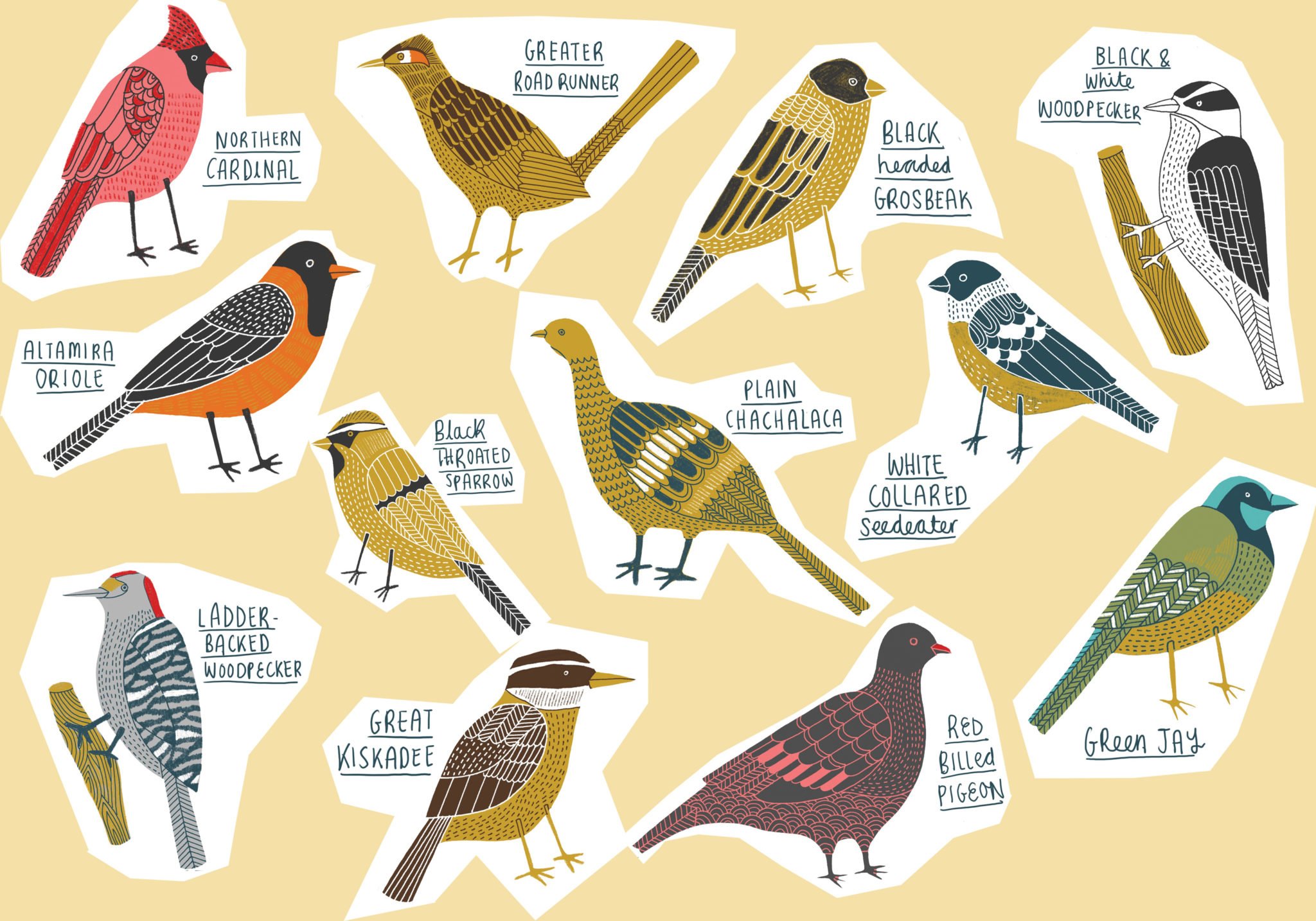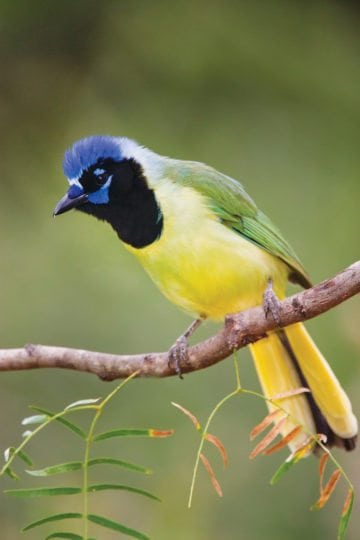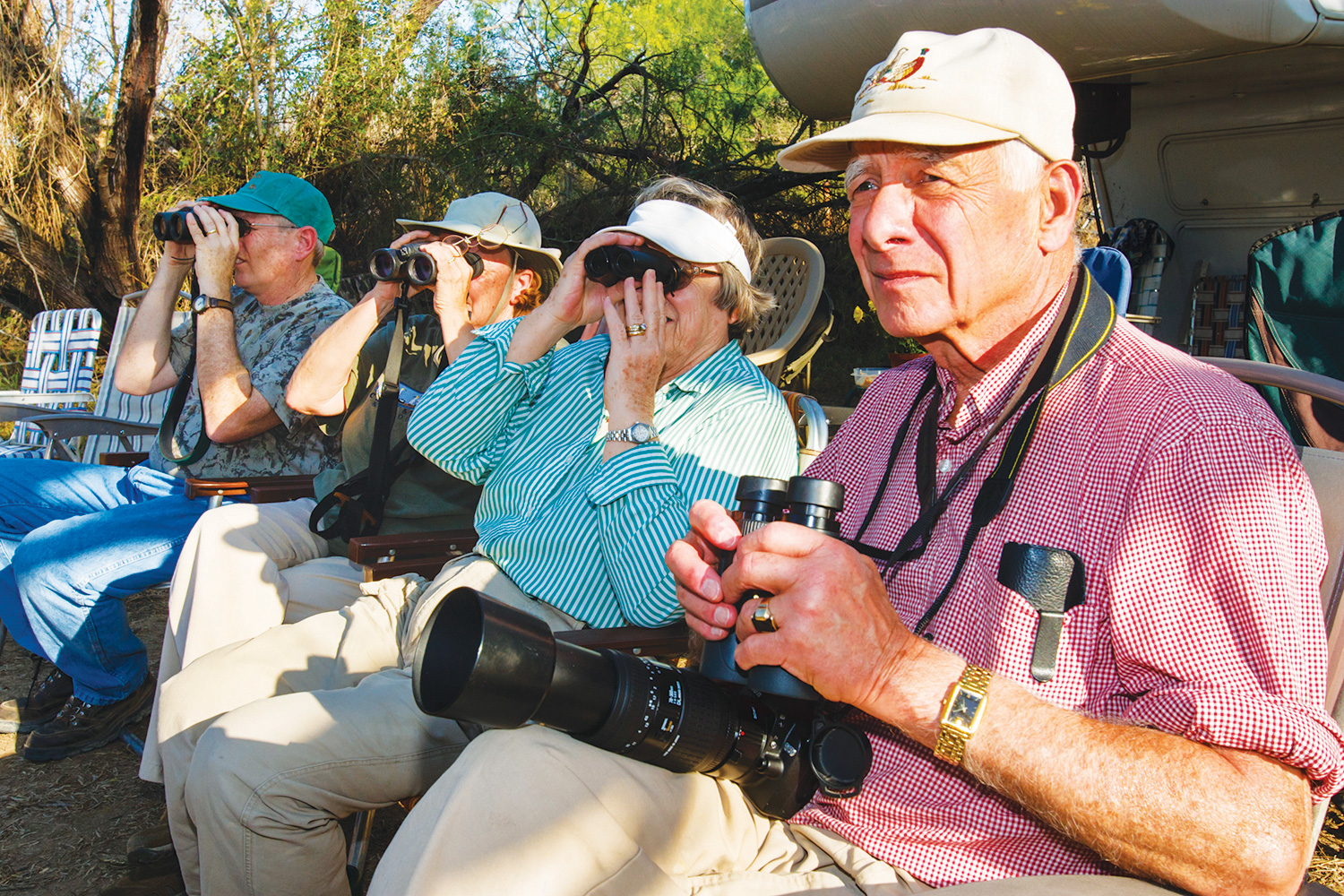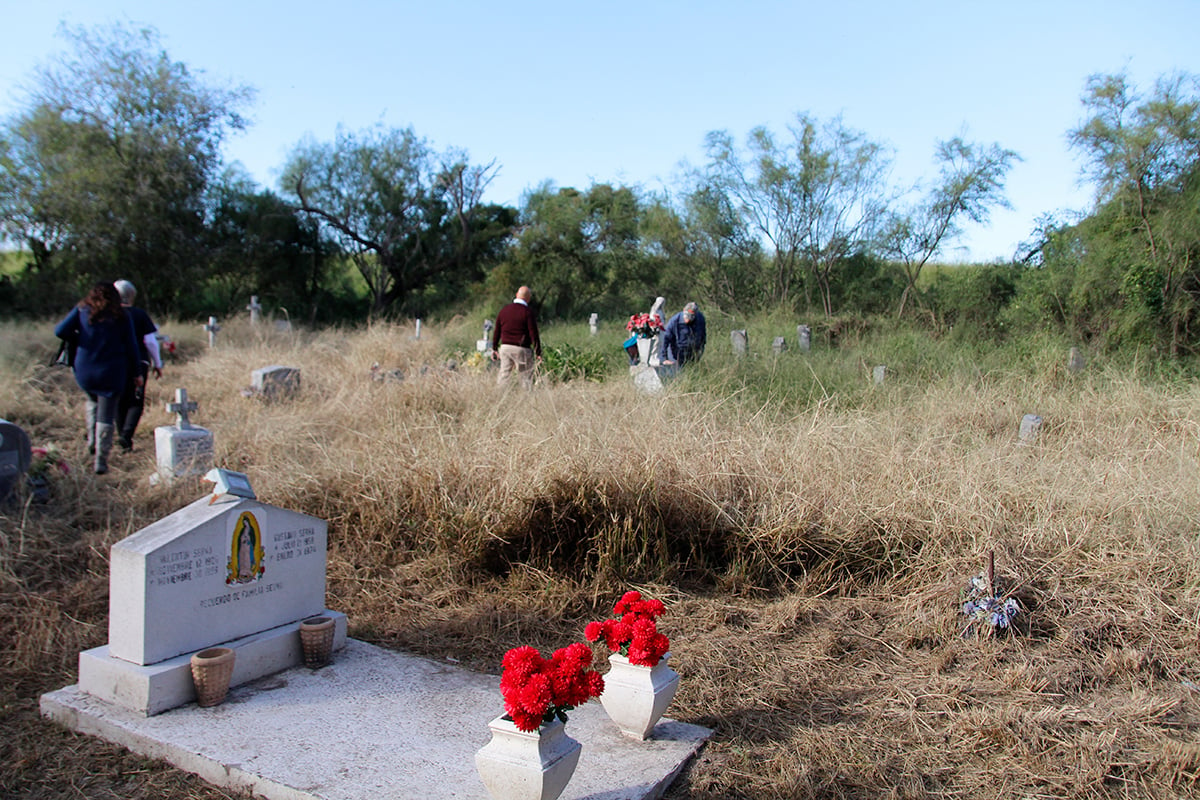
Swan Song
You won't find it on a highway map, but a 250-year-old village on the Rio Grande is internationally famous among birders. Will it survive Trump's wall?
A version of this story ran in the February 2018 issue.
Swan Song
You won’t find it on a highway map, but a 250-year-old village on the Rio Grande is internationally famous among birders. Will it survive Trump’s wall?
–
by Daniel Blue Tyx
@danielbluetyx
March 19, 2018
“Cha-cha-lac! chacha-lac!” As I crunched my way down a gravel path bound by an impenetrable thicket of mesquite and cacti, I heard the chicken-like tropical chachalacas raucously squawking a truncated version of their name. Moments later, a dog barked to announce my arrival, precipitating a flurry of beating feathers. By the time I glimpsed the RV around the corner, there were no birds left to see. “Don’t worry,” said Merle Ihne, looking up from a shovel that he was using to clear waist-high invasive guinea grass. Ihne, whose bushy white beard and jolly demeanor couldn’t help but invite Santa comparisons, pulled out a green plastic chair repaired several times over with makeshift plastic thread. He motioned for me to sit in the shade of the RV. “We can talk all we want, but the birds are sensitive to movement,” he said. “If we just sit still, they’ll be back.”

Sure enough, no fewer than a dozen green jays — a flamboyant lemon-and-lime bird, with a chivalric blue-and-black mask — reappeared instantaneously. They pecked at the branches of a few small mesquites that were slathered with a goopy mixture of peanut butter, lard and cornmeal. In a matter of minutes, the jays were joined in the “viewing area” — a backyard-sized clearing modestly outfitted with several bird feeders and a faucet dripping into a steel tub — by an entire rainbow-hued volary. Even an amateur birder like me could easily pick out red cardinals, yellow kiskadees, black-and-white woodpeckers and two different species of orange orioles, the Altamira and Audubon’s, which like the green jay and the chachalaca are rare “specialty” birds found only in the Rio Grande Valley within the United States. All told, there were more birds than I’ve ever seen any other place. Yet when Lois Hughes climbed down the RV steps behind me carrying a fresh batch of bird feed, she felt the need to apologize. “Things are still pretty slow,” she said. “There’ll be more birds in a couple of weeks, once the season starts.”
It was late October, and Hughes and Ihne were hard at work preparing for the Rio Grande Valley Birding Festival two weeks away. The festival marks the unofficial start of the winter birding season at the Salineño Preserve in western Starr County, about halfway between McAllen and Laredo. Like the 250-year-old village up the road for which it is named, the 2.5-acre preserve on the banks of the Rio Grande does not appear on any highway map, nor does it have a website or a Facebook page. For decades, word of mouth alone has drawn thousands of annual visitors to a location so remote that the hosts resort to waving their phones over their heads to attempt to send or receive text messages.
Ihne, 76, is a retired environmental science professor. Hughes, 74, has worked “more jobs than I can count,” the last operating a one-woman sheep and goat farm. Both divorced, they met online in 2007. A year later, they were towing an RV from Iowa to South Texas to volunteer with the U.S. Fish and Wildlife Service (USFWS), first as canoe guides and then as the preserve’s caretakers — a journey they have repeated every year since.
“When you start talking about the land that would have to be cleared, it’s all the way from the river to the town. This place wouldn’t exist anymore.”
Though there have always been rumors of illicit activity at the boat landing a few hundred feet from their trailer — two major drug busts have occurred in the area in the last five years — both Hughes and Ihne say they have never felt in danger. But late this summer, as Ihne watched cable news at home in Iowa, he was alarmed to see a Customs and Border Protection map of proposed border wall sections flash onscreen. Right away, Ihne could tell that the bright red line cut through the preserve.
The Salineño Preserve is one of many wildlife sanctuaries — including better-known destinations like the Santa Ana National Wildlife Refuge, the National Butterfly Center and Bentsen-Rio Grande Valley State Park — at grave risk if Trump’s wall is built as planned. The preserve’s tiny size and its location sandwiched between the river and the village mean that it could literally be wiped out. If the wall is built, it would at the very least cut off access to the riverside preserve. Potentially, it could be bulldozed entirely as part of a planned 150-foot enforcement zone.
“When you start talking about the land that would have to be cleared, it’s all the way from the river to the town,” Ihne said. “This place wouldn’t exist anymore.”
–
For all the array of colors on feathery display, it was a drab brown bird with a curved orange bill that first turned Salineño into an international birding sensation. In the 1980s, when the property was an off-the-grid trailer park community of roughly a dozen winter Texans, entire families of brown jays began to cross over from the Mexican side of the river — drawn, according to birding lore, by the fried chicken skins that resident Gale Dewind would mix in with the bird feed as a special treat. Since the jay was found nowhere else north of the border, Salineño became a pilgrimage site for birders anxious to mark it off their American Birding Association (ABA) checklists, which exclude Mexico. They came for the jay, but stayed to trade stories with Gale and Pat Dewind, who tended the feeders for 23 years before donating the property to the nonprofit Valley Land Fund; today, it’s operated through a joint management agreement with USFWS. “Salineño is dynamite,” said Sandy Komito, the record-setting birder portrayed by Owen Wilson in the film The Big Year. “It was the best place for the brown jay, but also just a delightful place to sit and see marvelous birds.”
When Gale was no longer in good enough health to make the trip from Michigan, the brown jays mysteriously stopped crossing the river. But even without the stars of the show, the birders have kept coming, as documented by the sign-in binders that Hughes and Ihne keep prominently displayed on a table in the viewing area. Organized by state and country — England and Japan alone fill up dozens of pages — the binders themselves have become part of the preserve’s appeal as birders search for other Salineño pilgrims from their home communities. And, over the years, other rare birds have taken up residence here — chief among them the red-billed pigeon and white-collared seedeater, both tropical birds that can’t be spotted anywhere else in the Valley.

While Ihne chatted up a California couple who had stopped by to donate bushels of citrus for the birds, Hughes and the couple’s dog Shammy led me on a hike by the river. At the boat landing, an osprey dipped into the water and emerged with a wriggling fish, which it transported to a branch on the other side. “With some of the songbirds that flit back and forth across the river,” Hughes said, “the hardcore birders will sit here until it flies to this side, so they can tick it off their ABA lists. It’s like, ‘You do know that they fly back and forth, right?’”
We proceeded on an undulating dirt road freshly marked with Birkenstock prints and the tires of Border Patrol ATVs, stopping every few seconds to listen for a call or take in a new sighting. “We might see Border Patrol, although I doubt it,” Hughes said. She turned and pointed to a white blimp hovering in the distance. “That’s our Big Brother,” she said. “They have cameras like you wouldn’t believe — we’ve been told they can read a license plate from up there. So, by the direction that we’re moving, and the speed, they can tell, ‘Oh, it’s those crazy birders again.’”
Our hike yielded more than a dozen species we hadn’t found at the viewing area, but no pigeons or seedeaters. Still, we did spot something even more unusual. Standing on a few boulders where a dry arroyo met the river, Hughes pointed out a grove of Montezuma cypress trees upriver. Once ubiquitous along the Rio Grande, there are now fewer than a dozen remaining in the entire Valley — the majority in a single grove at Salineño.
The trail ended, and Hughes and I turned back in the direction of the RV. Later, though, I retraced our steps and continued cross-country, clawing my way through brambles and sliding down the riverbank on my rear end where no flat terrain could be discerned. At last, I pushed my way out of the thicket into a clearing beneath the trees’ canopy, where the temperature seemed to drop 10 degrees. Climbing from one massive, centuries-old trunk to another by way of a maze of interconnected roots that protruded from the muddy water, I had the feeling of traveling back in time.
–
The village of Salineño — technically just a census-designated place, with a population of 200 — is located only a tenth of a mile up the road from the preserve, but practically exists in a different universe. The two groups have little contact aside from a few roadside snack shacks that occasionally sell tacos and Cokes to birders, and a group of local kids who ride their bikes down the rutted dirt road to check out what the fuss is about at the preserve. Nonetheless, as news of the border wall has filtered in, birders and village residents have made common cause in opposition to a structure that would permanently cleave one place from the other.
In a pink house a block from the village’s main plaza, 89-year-old Elvira Canales showed me the handwritten arból de la descendencia — family tree — she has begun compiling with her daughter Melissa. Thus far, Canales has traced her ancestors in Salineño back to her great-great-grandparents, although she believes part of the family has lived there since the mid-1700s. In October, Canales voiced her concerns about the planned wall at a community forum in nearby Roma that was hosted by the Texas Civil Rights Project. Canales fears that a border wall would produce unintended consequences like flooding, as well as cut the community off from the river, where residents gather during the weekend to fish and picnic. She worries the wall would sever the community from its past. “Why are they doing this now?” Canales wondered. “It’s been like this my whole life.”
“We’ve been told they can read a license plate from up there. So, by the direction that we’re moving, and the speed, they can tell, ‘Oh, it’s those crazy birders again.’”
Canales’ roots in Salineño are inextricably woven with the land, the community and the river. As a child, she swam and washed clothes with her mother in the Rio Grande. Occasionally, she would cross the river on her uncle’s shoulders — the water was shallower before the construction of Falcon Dam in 1954 — to visit family or go grocery shopping across the border in Mier, only 3 miles away as the crow flies. In adulthood, she became village postmaster, which in a community without door-to-door delivery meant she knew everyone, including the winter Texans. She called upon this extensive social network to spearhead a campaign to bring running water to the village in 1974. Before that, a local man scooped water from the Rio Grande and delivered it via truck to residents’ cisterns; the county rationed out chlorine tablets based on the size of the container.
Melissa drove us on a tour of the village. We started at the cemetery, where nearly every silk-flower-festooned tombstone was inscribed with one of the half dozen last names scrawled many times over in the family tree: Canales, Castillo, García, Talamante, Ramos, Hinojosa. For most of her adult lifetime, Canales had been keeper of the libro de cementerio — the cemetery book — in which she officially recorded the name and location of each resident interred there. The oldest tomb, surrounded by paupers’ graves whose wooden markers had long since rotted away, was an above-ground brick structure topped with a wrought-iron cross. It belonged to Rafael Ramos, Elvira’s great-grandfather, who passed away in 1905.
Driving through town, we passed Ramos’ house, still occupied, although it has since been covered with a 1950s-era brick façade. We also drove by her uncle Manuel Hinojosa’s house. Now the 19th century structure’s crumbling walls offered a cutaway view of one of the few remaining examples of a jacal — a pre-Columbian dwelling, later adopted by settlers, built from mesquite poles filled in with sticks, mud and grass.
“To think that we won’t be able to go here anymore because of the wall — all of our memories are here.”
We ended at the boat landing. Earlier, Melissa had shown me a pair of snapshots of two young cousins wading in the river during a family reunion the previous summer. She wanted to take me to the place where the family had gathered. Elvira stayed behind as we walked up the uneven dirt path; it turned out the photo was taken at the place where the arroyo fed into the river, and where I had first glimpsed the Montezuma cypresses.
“The river has been there for ages,” Melissa told me as we turned around and headed back to her mother, waiting in the car. “To think that we won’t be able to go here anymore because of the wall — all of our memories are here.”
–
If Congress ultimately approves funding for the 32 miles of border wall that Customs and Border Protection has proposed for Starr County, acquiring the privately owned Salineño Preserve won’t require a huge investment, though it might trigger a lengthy condemnation process. The preserve is appraised at less than $8,000, according to Debralee Rodriguez, executive director of the Valley Land Fund. “But the value … is so much more,” she said. “If you could somehow multiply its worth by each person who visits — there must be a way to measure the true value of a piece of land to conservation, and to people.”

When I came back to Salineño over the birding festival weekend, the parking lot was nearly full. Taking a seat beside Hughes and Ihne at the feeders, we were soon joined by a band of nine teenagers (plus two adult chaperones) — the Blue Ridge Young Birders Club of Charlottesville, Virginia. They sat in two rows in front of us, binoculars moving in concert each time a new arrival flew in, cameras snapping photos at rapid-fire pace.
After 15 minutes of bird-watching reverie, the club members came over to add the names of a new generation of birders to the sign-in binders. Sixteen-year-old Max Nootbaar, the club’s president, explained that the group had come to Salineño on a tour bus the previous day, but had returned on their own in search of the seedeater. Proudly, he leaned over to show us the photo he had shot — the teens had found their target bird early in the morning, photogenically perched near the top of the cane. “It’s been great, gotten a lot of cool birds,” Nootbaar said, when I asked about the club’s trip so far. “I’ve already added 55 new birds to my life list, a lot of them right here.”
Later, after the preserve had closed for the day and most of the birds had gone off to roost, I sat with Hughes and Ihne watching the chachalacas work as a cleanup crew, devouring the leftover sunflower seeds the careless green jays had pecked off the platform feeder. “It’s such a beautiful place,” Hughes said, lingering a few more moments before returning the binders, the loaner binoculars and the brown jay T-shirts to the “basement,” a small storage area beneath their RV. “It’s such a privilege to be around all these birds all the time. We’ll keep it going for as long as we can.”
Illustration by Kate Sutton.


